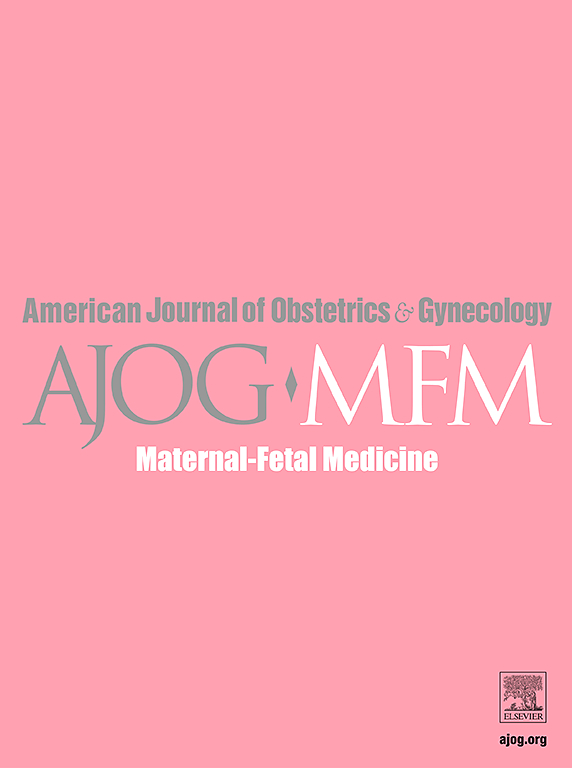Risk factor stratification for urgent and nonurgent transfusion in patients giving birth
IF 3.8
2区 医学
Q1 OBSTETRICS & GYNECOLOGY
American Journal of Obstetrics & Gynecology Mfm
Pub Date : 2024-09-21
DOI:10.1016/j.ajogmf.2024.101506
引用次数: 0
Abstract
Background
A common approach to attempt to reduce maternal morbidity from hemorrhage is to recognize patients at increased risk, and to make advance preparations for possible blood transfusion in these patients. Preparation may consist of a hold clot, type, and screen, or crossmatch. Most hospitals, including ours, have pathways or guidelines that lay out which of these preparations should be made at the time a patient is admitted to labor and delivery. These are often based on risk factors for hemorrhage but do not take into account the probability that transfusion will be needed. The cost-effectiveness of performing a type and screen or routine crossmatch on patients admitted for delivery has been questioned. Several studies have shown that the chance of transfusions in individuals giving birth is very low. In terms of the need for routine blood preparation, the need for urgent transfusion is most relevant. This has not been included in studies of transfusion rates.
Objective
The purpose of this study was to quantify the relative importance of risk factors present on admission for needing a blood transfusion and to develop a formula to define each individual's risk. This could then be used to decide an appropriate level of initial blood preparation for patients at different risk levels.
Study Design
Risk factors for hemorrhage and the level of transfusion preparation were extracted from the medical records of a cohort of 89,881 patients delivering in an 18-hospital healthcare system over 40 months. We tabulated the number who required at least one RBC transfusion and the number needing an urgent transfusion-defined as receiving blood during labor or within 4 hours after delivery. Odds ratios for requiring a transfusion were calculated for each risk factor. We then calculated the probability of needing a transfusion for each patient based on their risk factor profile.
Results
A total of 643 patients had any transfusion during their hospitalization (0.72% of deliveries), and 311 had an urgent transfusion (0.35% of deliveries). The calculated probability of needing a transfusion was less than 1% in 87.8% of patients and was greater than 5% in 1.2% of patients. The chance of needing a transfusion was highest for placenta accreta spectrum, admission Hgb <8.0, and placenta previa. A second tier of risk factors included abruption, bleeding with no specific diagnosis, and Hgb between 8.0 and 10.0.
Conclusion
In our cohort, very few patients received a transfusion. Applying a formula derived from patient-specific risk factors, we found that almost all patients have a very low probability of needing a transfusion, especially an urgent transfusion. Based on these results, we suggest that a hold clot be used except for the highest-risk patients or in settings with barriers to procuring blood in the rare case of urgent transfusion need. Making this change would greatly reduce hospital blood bank charges.
产妇紧急和非紧急输血的风险因素分层。
背景:试图降低产妇因大出血而发病率的常用方法是识别风险较高的患者,并为这些患者可能的输血提前做好准备。准备工作可能包括保留血块、配型和筛查或交叉配血。包括我们医院在内的大多数医院都制定了路径或指南,规定病人在入院分娩时应做哪些准备。这些通常基于出血的风险因素,但没有考虑到需要输血的可能性。对入院待产患者进行配型和筛查或常规交叉配血的成本效益受到质疑。多项研究表明,产妇输血的几率非常低。就常规备血需求而言,紧急输血需求最为相关。输血率的研究并未包括这一点:本研究的目的是量化入院时存在的需要输血的风险因素的相对重要性,并制定一个公式来定义每个人的风险。研究设计:研究设计:我们从一个 18 家医院的医疗保健系统中 89,881 名分娩患者的病历中提取了出血风险因素和输血准备水平,这些病历历时 40 个月。我们统计了至少需要输一次红细胞的人数和需要紧急输血的人数,紧急输血的定义是在分娩过程中或产后 4 小时内接受输血。我们根据每个风险因素计算出了需要输血的风险比。然后,我们根据每位患者的风险因素情况计算出其需要输血的概率:643名患者在住院期间接受了任何输血(占分娩总数的0.72%),311名患者接受了紧急输血(占分娩总数的0.35%)。经计算,87.8%的患者需要输血的概率小于 1%,1.2%的患者需要输血的概率大于 5%。需要输血的几率在胎盘早剥谱系、入院血红蛋白结论中最高:在我们的队列中,只有极少数患者需要输血。应用根据患者特定风险因素得出的公式,我们发现几乎所有患者需要输血,尤其是紧急输血的概率都非常低。基于这些结果,我们建议,除了风险最高的患者,或在极少数需要紧急输血的情况下,在采购血液存在障碍的情况下,应使用暂存血块。这一改变将大大降低医院血库的收费。
本文章由计算机程序翻译,如有差异,请以英文原文为准。
求助全文
约1分钟内获得全文
求助全文
来源期刊

American Journal of Obstetrics & Gynecology Mfm
Medicine-Medicine (all)
CiteScore
7.40
自引率
3.20%
发文量
254
审稿时长
40 days
期刊介绍:
The American Journal of Obstetrics and Gynecology (AJOG) is a highly esteemed publication with two companion titles. One of these is the American Journal of Obstetrics and Gynecology Maternal-Fetal Medicine (AJOG MFM), which is dedicated to the latest research in the field of maternal-fetal medicine, specifically concerning high-risk pregnancies. The journal encompasses a wide range of topics, including:
Maternal Complications: It addresses significant studies that have the potential to change clinical practice regarding complications faced by pregnant women.
Fetal Complications: The journal covers prenatal diagnosis, ultrasound, and genetic issues related to the fetus, providing insights into the management and care of fetal health.
Prenatal Care: It discusses the best practices in prenatal care to ensure the health and well-being of both the mother and the unborn child.
Intrapartum Care: It provides guidance on the care provided during the childbirth process, which is critical for the safety of both mother and baby.
Postpartum Issues: The journal also tackles issues that arise after childbirth, focusing on the postpartum period and its implications for maternal health. AJOG MFM serves as a reliable forum for peer-reviewed research, with a preference for randomized trials and meta-analyses. The goal is to equip researchers and clinicians with the most current information and evidence-based strategies to effectively manage high-risk pregnancies and to provide the best possible care for mothers and their unborn children.
 求助内容:
求助内容: 应助结果提醒方式:
应助结果提醒方式:


